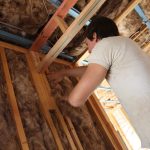Your roof plays an important role in the energy efficiency and comfort in your home, but it doesn’t do it alone. It’s greatly helped by having vents that keep air circulating throughout the space between your living area and roof, even if you don’t have a traditional attic space. Understanding the purpose and value of your roofing ventilation makes it easier to appreciate the need to include this step in a roofing repair or replacement going forward.
The Benefits of Ventilation
Roof vents allow the circulation of air through the attic. This healthy circulation helps controls moisture and aids in temperature control. During warm weather, a well-ventilated attic releases hot air from the space. Without proper roofing ventilation, this heat will continue to build and force the air conditioning system to work harder to keep the home comfortable.
During colder months, the air in the attic can become too damp as heat radiating from inside the home collides with the coldness of the roof. The dampness can cause damage to the attic and increase the risk of mold growth. The constant overheating and cooling in the attic space can cause ice dams on the roof and degrade shingles and other roofing materials. Over time, this will force you into making repairs or undergo a roofing replacement much sooner than if you had better ventilation.
Make a Plan for Roofing Ventilation
Roofing experts estimate that the average home needs approximately one vent for every 300 square feet of attic floor space. The exact amount each home needs, however, will vary depending on the size and shape of your roof as well as the attic space below it. The variations can occur because of the design of the roof and the regional climate. Choosing the correct number avoids having too much ventilation, which can cause the same problems as not having any air circulation.
Choose the Right Vents
Homeowners also need to decide on the type of roof vents they need. Most homes will have more than one type of vent installed to ensure circulation. The options available for vents include ridge, soffit, and box vents. These traditional options fit into holes cut into the roof or the eaves.
Other roofing ventilation options can also include the upgraded and more costly choice of hard-wired and solar vents. These larger vents often have fans for more consistent air movement. Roofers primarily use the larger vents and fans in commercial buildings because of the size of their attic space and the higher temperatures generated in the buildings. The option could offer an effective solution for large-sized residential properties but is not usually necessary for average-sized homes.
Maintain Your Roofing and Its Vents
Maintaining roof vents does not add much cost or time to annual repairs, but it can play a vital role in extending the life of your roof. The purpose of maintenance checks of roof vents is to keep out water, debris, and animals seeking a nesting spot. An inspection ensures that any vent covering, flashing, or other material does not need repair or replacement. Performing these checks during annual or biannual roof cleanings and maintenance services will help avoid roof damage.
Whether You Need a New Roof, Ventilation, or Both, Get in Touch with the Experts at Schmidt Roofing for a Free Quote Today!





